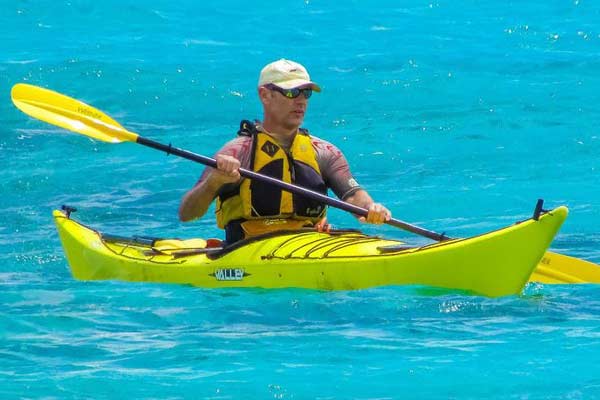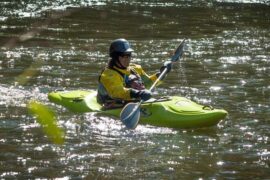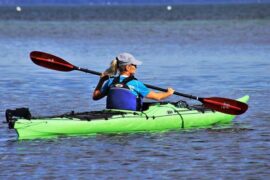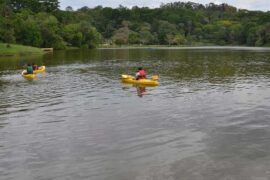Kayak fishing has been growing in popularity recently, with many anglers switching from traditional fishing boats to save money.
The ultra-lightweight nature of these boats makes them ideal for fishing. Anglers can easily fish in an area where they wouldn’t have been able to with a boat that had to have a lot of room for gear.
The live well and the storage space it provides are desirable features that set apart a top-tier fishing kayak from an ordinary one.
A good live well will allow you to keep your catch alive and dry for longer than a cooler. Also, if you’re fishing for bigger fish or venturing offshore, it will help keep your live bait active.
Fishing kayaks include many storage areas that may be transformed into live wells using movable or fixed hardware.
Keeping your tackle boxes and other gear inside your kayak can protect them from the extremes while you fish.
What Are the Most Common Types of Live Wells?
There are several different types of live wells designed for fishing.
1. The Aerated Live Wells
Pumps in aerated live wells constantly move air throughout the space. They are made of plastic or metal material with a filter system.
They often have a drain-off valve to empty water that may build up. These live wells are often spacious and easy to clean; they are cheaper than other types of live wells.
2. Unaerated Live Wells
These are also referred to as “dry wells.” These live wells lack aeration but use insulation and unique design features to keep the water from becoming stagnant.
They are unpressurized and usually made of hard plastic. They are usually easy to clean and are not made to obtain large amounts of water.
3. Bait Buckets
They may be made of metal or plastic; they often have a lid but no drain plug. They are mainly used to store bait and are not intended for live fish storage but can also be used for that purpose.
4. Portable Tanks
They are small tanks attached to the kayak by a hose. Due to its built-in filtering system, you may quickly move portable tanks from one vessel to another. They are made of hard plastic or metal and often have an easy-to-read gauge and a waterproof cap.
How Long Do Fish Typically Survive in A Live Well?
Fish have a median survival rate of 8 hours in a standard live well. Depending on the design of the live well you install in your kayak, you may be able to keep fish alive and fresh for up to six hours.
If you choose the cooler and don’t add freshwater, your fish or bait could only last three to four hours.
It’s not a good idea to overcrowd your life well; therefore, the more fish or bait you want to keep in it, the bigger Livewell you’ll need.
A kayak is a little boat, so you won’t have as much room as you would in a larger vessel. Without regular access to clean water, fish have little chance of survival.
Water temperature significantly affects the survival time of your live bait and live wells. Water 20 degrees above 64 degrees Fahrenheit will have a much shorter survival time than water kept at a cooler temperature below 64 degrees F.
Is There a Benefit to Adding a Live Well to Your Fishing Kayak?
Wells come in handy for several reasons. They provide a safe place to store live bait, can be used as a place to keep ice, can be used to clean the water, and are an excellent source of oxygen for your fish.
If you want your live bait to last as long as possible without damage, you should get yourself one of these handy appliances.
Here are the various advantages to having a livewell on your kayak:
- A livewell adds storage space for your tackle, lines, and hooks.
- A livewell can be a convenient place to stow your fishing license and other gear that goes with you on the kayak fishing trip.
- You can use a livewell as a portable water storage system for your kayak.
- You can keep the small game alive in your live-well, such as trout, perch, and catfish.
Do I Need a Live Well?
The kind of fish you’re targeting will determine whether or not you need a live well in your kayak to keep your catch alive, as will your motivations for obtaining fish (edible or competitive). If you plan on practicing catch-and-release, you probably won’t need a live well.
If you plan on using live bait, you’ll need to ensure that the fish won’t perish while you’re out on the water. You may store your catch in the kayak’s storage area even if you’re not fishing. However, doing so will cause the kayak to stink very quickly.
How Do I Need to Keep My Live Well and Storage Clean?
To ensure that your livewell and storage maintain their cleanliness, follow these simple tips:
- Wash the inside of the live well with warm water and mild detergent.
- Clean the outside with a nylon brush or soft cloth to remove any dirt or debris hanging onto it.
- Use the home sink to clean your livewell regularly and air dry after washing it.
- Don’t forget to rinse and dry your livewell after use.
- Avoid using bleach or other cleaners designed for disinfecting to maintain the water quality in your livewell.
- Avoid overfilling the live well, as this can make cleaning it difficult and lead to faster bacterial growth on surfaces submerged in water for extended periods.
A live well will prevent your fish from dying and keep them fresh for longer periods. Having one in your kayak is a huge benefit that allows you to stay on the water longer, enjoy nature and have a more efficient day fishing.




